![]()
![]()
![]()
Use LEFT and RIGHT arrow keys to navigate between flashcards;
Use UP and DOWN arrow keys to flip the card;
H to show hint;
A reads text to speech;
48 Cards in this Set
- Front
- Back
- 3rd side (hint)
|
Ability Leadership is an ability |
Leadership ability is able to be a leader. Leadership is conceptualized as an ability. In leadership, some people have the natural ability to lead. (4)
Leadership is conceptualized as an ability. A person who has leadership ability is able to be a leader, that is, has the capacity to lead. Page 4 |

|
|
|
Authentic leadership |
A leadership approach that looks at the authenticity of leaders and their leadership is enjoying strong interest. (3) |
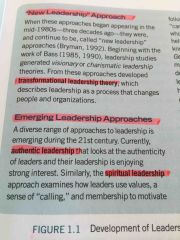
|
|
|
Behavior approach Leadership is a behavior |
A leadership theory that focus on behavior - what leaders do and how they act (2) It is what leaders do when they are in a leadership role. Page 5 |

|
|
|
Contingency theory |
Focuses on the match between the leader style and specific situational variables. Page 2 |
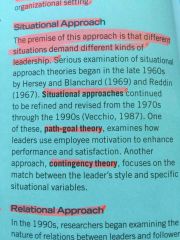
|
|
|
Great man theories |
Focused on identifying that innate qualities and characteristics possessed by great social political and military leaders such as Catherine the great, Mohandus Gandhi, Abraham Lincoln, Moses and Joan of Arc. Page 2 |
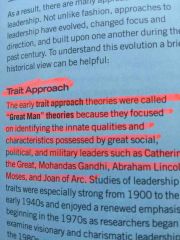
|
|
|
Leadership |
A process whereby an individual influences a group of individuals to achieve a common goal. Page 6 |
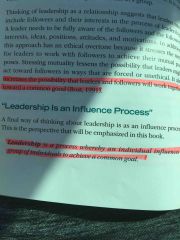
|
|
|
Path-goal Theory |
Situational approach that examines how leaders use employee motivation to enhance performance and satisfaction. Page 2 |
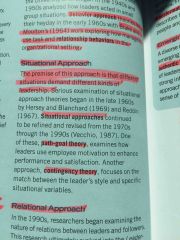
|
|
|
Process behaviors |
Used by leaders to help people feel comfortable with other group members and at ease in the situations in which they find themselves. Page 6 |
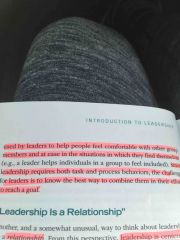
|
|
|
Relational theory Leadership is a relationship |
Nature of relations between leaders and followers. LMX Theory predicts that high quality relations generate more positive leader outcomes than low quality relations. Page 2 Leadership is centered on the communication between leaders and followers rather than on the unique qualities of the leader. Relationship leadership becomes a process of collaboration that occurs between leaders and followers. Page 6 |

|
|
|
Relationship Behaviors |
Focus on what leaders do and how they act. Page 2 |
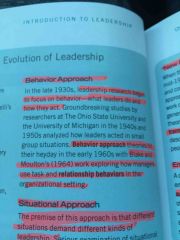
|
|
|
Servant leadership |
Emphasizes the caring principle with leaders as servants who focus on their followers needs in order to help these followers become more autonomous, knowledgeable, and like servants themselves. Page 3 |

|
|
|
Situational approach |
Different situations demand different kinds of leadership. Page 2 |
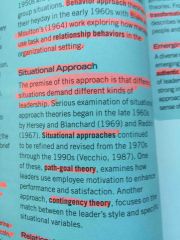
|
|
|
Skill Leadership is a Skill |
Competency developed to accomplish a task effectively.
Describing leadership as a skill makes leadership available to everyone because skills are competencies that people can learn and develop. Page 5 |

|
|
|
Spiritual Leadership |
Approach that examines how leaders use values, a sense of calling, and membership to motivate followers. Page 3 |
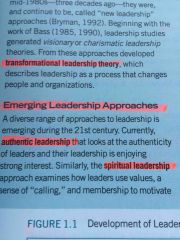
|
|
|
Task behaviors |
Task behaviors are used by leaders to get the job done i.e. a leader prepares an agenda for a meeting. Page 5 |
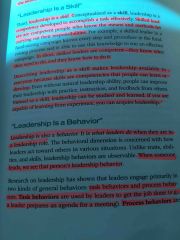
|
|
|
Task Behaviors |
Used by leaders to get the job done i.e. a leader prepares an agenda go a meeting. Page 5 |
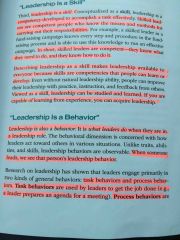
|
|
|
Trait Leadership is a trait |
A trait, is a distinguishing quality individual, which is often inherited. Defining leadership as a trait means that each individual brings to the table certain qualities that influence the way he or she leads. Page 4 |

|
|
|
Trait approach |
Focused on identifying the innate qualities and characteristics possessed by great leaders. Page 2 |
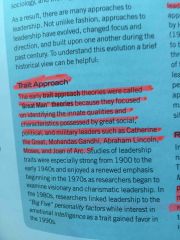
|
|
|
Transformational Leadership Theory |
Describes leadership as a process that changes people and organizations. Page 3 |
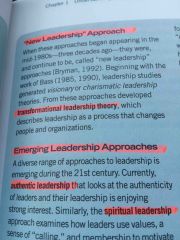
|
|
|
Leadership in an influence peocess |
Influence is central to the process of leadership because leaders affect followers. Leaders direct their energies toward influence and individuals to achieve something together. Page 7 |
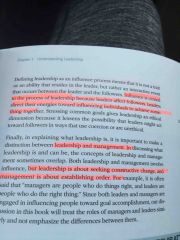
|
|
|
The Globe Project Global leadership and organizational behavior effectiveness |
In 2004, Robert House Led a group of 160 researchers to increase our understanding of the impact culture has on leadership effectiveness. 17000 people in 62 countries. Developed positive and negative leadership characteristics that are universally accepted worldwide. Page 7 |
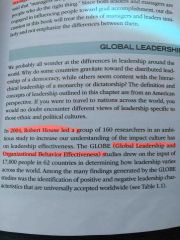
|
|
|
Universal leadership attributes |

Back (Definition) |
|
|
|
Charisma |
Charisma refers to a leaders special magnetic charm and appeal and can have a huge effect on the leadership process. Charisma is a special personality characteristic that gives a leader the capacity to do extraordinary things. Page 24-25 |
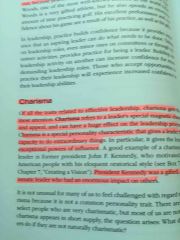
|
|
|
Confidence |
Confidence is a trait that has to do with feeling positive about ones ability to succeed. Page 23 |
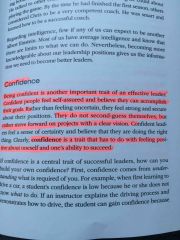
|
|
|
Determination |
Determination is another trait that characterizes effective leaders. Determined leaders are very focused and attentive to tasks. Page 25 |
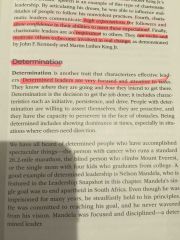
|
|
|
Integrity |
One of the most important factors of an effective leader is that they have integrity. Integrity characterizes leaders who possess the qualities of honesty and trustworthiness. Page 27 |
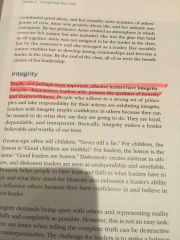
|
|
|
Intelligence |
Intelligence is an important trait related to effective leadership. Intelligence includes having good language skills, perceptual skills, and reasoning ability. This combination of assets makes people good thinkers and makes them better leaders. Page 22 |
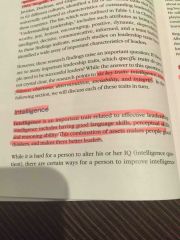
|
|
|
Sociability |
An important trait for leaders is sociability. Sociability refers to a leaders capacity to establish pleasant social relationships. Page 26 |
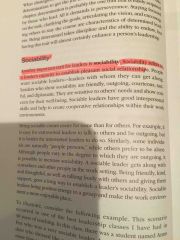
|
|
|
Gallup organization |
Gallup organization conducts research in the social sciences and the late Donald oh Clifton created and published strengths finder profile an online assessment of people's talents and potential strengths. Page 51 |

|
|
|
Learned behaviors |
Learned behaviors represent those ingrained things we have learned throughout our life experiences. Page 60 |
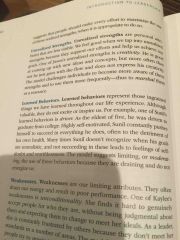
|
|
|
Positive psychology |
Introduced by Martin Seligman positive psychology is defined as the scientific study of what makes life most worth living. Page 52 |
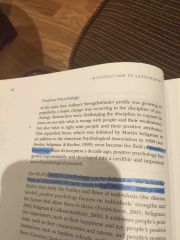
|
|
|
Realized strengths |
Really strengths are personal attributes that represent our strongest assets. We are energized when we use them because they help us perform well. Page 59 |

|
|
|
Themes of human talent |
Gallup researchers identified themes of human talent, not strengths. Talents are similar to personality traits, they are relatively stable, fixed characteristics that are not easily changed. From talents, strengths emerge. Page 53 - 54 |

|
|
|
Strength |
Strength is an attribute or quality of an individual that accounts for successful performance. Buckingham and Clifton suggest that strengths are the ability to consistently demonstrate exceptional work. Linley defines strength as a pre-existing capacity that is authentic and energizing and enables peak performance. Page 50 |

|
|
|
Unrealized strengths |
Unrealized strengths are personal attributes that are less visible. Page 60 |
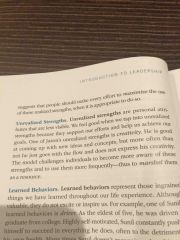
|
|
|
Weaknesses |
Weaknesses are our limiting attributes. They often drain our energy and result in poor performance. Page 60 |
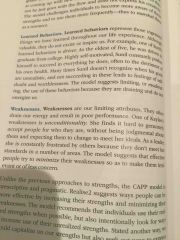
|
|
|
Strengths-based leadership, Rath and Conchie 2008 |
Developed the four domains of leadership strengths which are executing, influencing, relationship building, strategic thinking. Page 55 |
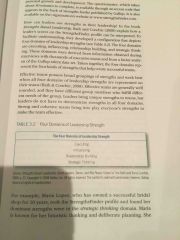
|
|
|
Values in action Institute |
Led by Martin Seligman and Christopher Peterson in the area positive psychology defined and conceptualized character strengths. This included wisdom and knowledge, courage, humanity, justice, Temperance, transcendence. These are the six universal core virtues. Page 57 |
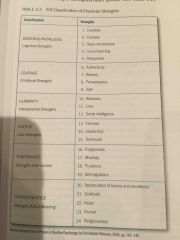
|
|
|
Center applied positive psychology and realize2 assessment |
CAPP in the United Kingdom developed an approach to strengths that differs from the approaches in Gallup strengths finder and the values in action perspectives. They focused on realized strengths,unrealized strengths, learned behaviors, and weaknesses. Page 58 and 59 |
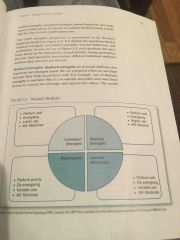
|
|
|
Philosophy of leadership |
Each of us approaches leadership with a unique set of beliefs and attitudes about the nature of people and the nature of work. This is the basis for our philosophy of leadership. Page 83 |
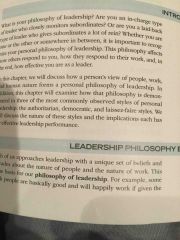
|
|
|
The human side of enterprise 1960 by Douglas McGregor |
McGregor believed that managers need to understand their court assumptions about human nature and assess how these assumptions relate to their managerial practice. Page 84 |
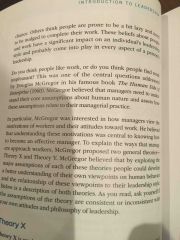
|
|
|
Theory X |
Siri X is made up of three assumptions about human nature and human behavior. Assumption won the average person dislikes work and will avoid it if possible. Assumption two people need to be direct and controlled. Assumption three people want security, not responsibility. Page 84 and 85 |
|
|
|
Theory y |
Theory y is based on several specific assumptions about human nature and behavior. Assumption one the average person does not inherently dislike work. Doing work is as natural as play. Assumption two people will show responsibility and self-control toward goals to which they are committed. Assumption three in the proper environment, the average person learns to except and Seck responsibility. Page 86 and 87 |
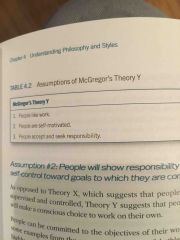
|
|
|
Leadership style |
Leadership style is defined as the behaviors of leaders focusing on what leaders do and how they act. Page 89 |
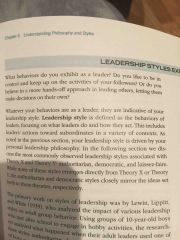
|
|
|
White and Lippett 1968 |
Came up with three styles of leadership. Authoritarian leadership style, Democratic leadership style, and laissez-faire leadership style |

|
|
|
Authoritarian leadership style |
Similar to Siri X. Authoritarian leaders perceive subordinates as needing direction, the leader needs to control subordinates and what they do, authoritarian leaders emphasize that they are in charge controlling all group members. Page 90 |
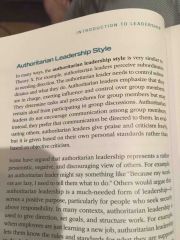
|
|
|
Democratic leadership style |
Democratic leadership strongly resembles theory Y. Democratic leaders treat subordinates as fully capable of doing work on their own. Leaders work with subordinates trying hard to teach everyone fairly, without putting themselves above the subordinates. Page 91 |
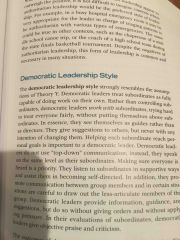
|
|
|
Laissez-Faire leadership style |
Is similar to both theory X and theory Y. LF leaders do not try to control subordinates as three Theory X leaders do and they do not try to nurture and guide subordinates as theory Y leaders do. They let their subordinates do what they want. Page 92 |

|

